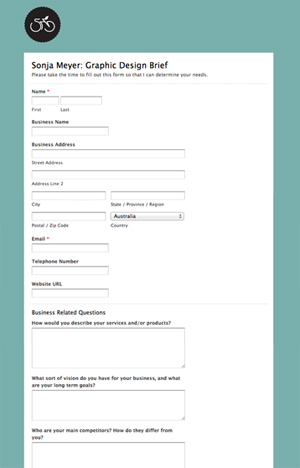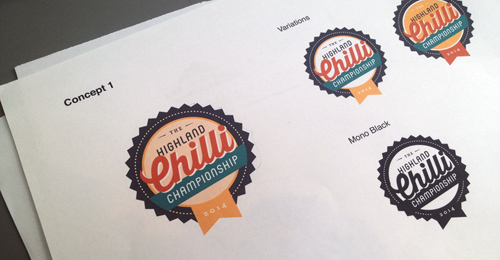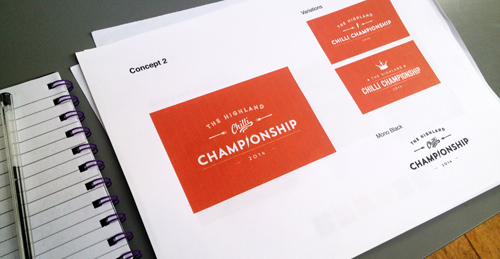Different designers may have a slightly different approach to the creative process, because what works for them may not work as well for someone else. I have put together a numbered list to outline the general process I like to employ for new design projects. This provides transparency and comfort for new clients as they will know what to expect. Every project is different and thus the process may vary slightly, but the general direction will always remain the same.
1. Initial contact
The first thing to do is get in touch with me – however you like – to discuss your project. You may prefer to talk on the phone or over Skype, or you may feel you are able to articulate yourself better over email. Whichever method you prefer, make contact with me and let me know about your potential design project. This way you can gauge whether or not I’m suitable for your project and how we might work together, and I can get an idea of what you envisage. I may give also provide you with a rough unofficial estimate of pricing at this stage if the brief appears straightforward. But the official quotation for signoff will be provided in step 3.
2. Detailed requirement & creative brief
This is the step where discuss your specific design requirements and deliverables. This step works well in person because we can begin to bounce ideas off each other and I can gain some context on your work environment, your values, your cultural influences and anything else that may help me to determine an approach that suits your needs. But if an in-context meeting can’t be arranged this can also be discussed over Skype. Whether we meet in person or not, I will also ask you to fill out a form that will help me put together a brief. This form will cover:

- Company background, vision, competitors, target market, unique selling points
- Expected itemised deliverables
- Potential timeline
- Project budget if you have one
- What sort of messages do you wish to communicate?
- How do the values and beliefs of all internal stakeholders fit in with this project, are there any objections to the message you will be publicising?
- Who are the main stakeholders and what is their role in the project?
- Any design limitations, ie style guides, branding that must be considered
Once this information has been provided and discussed, I will provide you with a copy of the final project brief. This way we will both have reference to it in order to keep track of the project and expected outcomes.
3. Quoting & agreement of terms
Once the brief has been put together I will provide an official itemised quotation. The quote will be broken down into deliverables or components depending on the size of the project and what we have decided. You will be able to see an estimate of how much time will be spent on each item and this will be multiplied with my hourly rate to create a total estimate. Any additional fees such as estimated amounts for stock photos, fonts etc will be listed and added to the total quotation. In order to begin the project work the following will be required:
- You will need to provide written consent that you accept the quotation. A reply email will suffice.
- You will be emailed a signed copy of my Terms & Conditions document, which will act as our contract. You will need to print this off and sign it and then scan and email it back (or send it by post).
- If you are a new client and the project quotation is above $300AUD you will be emailed an invoice for a 50% deposit. This amount must be paid before any work will commence. The terms of this deposit are outlined in the Terms & Conditions.
4. Research, inspiration & holistic design thinking
Before actually creating anything I need to get some inspiration that will provide me with a clear understanding of what this design project must achieve. This requires some research on things like competitor approaches and possible creative solutions that other designers have come up with in the past (not to copy, to get a clear understanding of tried and true techniques). What works and what doesn’t for projects of this type? What is the cliché approach in this sort of situation and why has this been successful? How can I use this information to create something unique but still appropriate, understandable and relatable/familiar? What emotional response is required of the viewer without being dishonest or tricky?
This is also the time to begin to look at imagery that might inspire the next step of concept creation. I start gathering images and graphics that appear inspiring and may help spark some creativity, whether they are related or far-removed from the design style I am leaning towards. I will also brainstorm a lot during this stage, writing out the beginnings of ideas and thinking about what sort of words or visual language can be associated with the design, and what this means.
The final process of this step is to actively think ‘outside the box’ about environmental, social and economic considerations. I might request some of your time to discuss which components of the project are most important and which are least important. For example you may have requested that I design an A4 foldable brochure, but after having examined the brochure content, I feel it may be more environmentally friendly and cost effective for you if we minimise the size of the brochure or consider a digital marketing piece instead. After listening to my thoughts and suggestions perhaps you will agree to a change in direction, or alternatively you may feel that the original size can’t be compromised as it works best to engage your target market (for example). In any case, we must work together with trust and integrity in order to decide on the appropriateness of any particular alternative eco or socially responsible solution to a component of the project.
5. Concept creation
Now we are at the stage where I have taken in a lot of information, and it’s time to give these ideas some form. This usually happens by sketching out anything and everything I can think of. I begin rough and then if I feel the idea has potential I will spend some time refining the sketch. I begin to play with styles and identify how the concept will work best within any existing branding. Or of course if it’s a branding project I will think about how the concept might work across print and digital media, and how this project will fit into the client’s overall marketing strategy. This step can take a while, because it’s important to have as many ideas as possible sketched out before I turn to the computer to begin working digitally. This makes it easy to see what doesn’t work, and quickly separate this from what does.
After I am satisfied with my sketches, I will begin to work on these concepts digitally, refining them and working on colour schemes and layout. I sometimes create a digital mood board in this stage to help me stay on track with the kind of look and feel I am going for. I will then put the final refined concepts together ready for presenting to the client.
6. Concept presentation


The design concepts can be presented either in person or sent by email as a PDF. This depends on the preference of the client and the situation (for example it’s not possible to present the designs in person if we are in different locations). Some people prefer to receive an email with the concepts attached so that they have time to take them in and process their response. I believe in any case – less paper printouts is always better than printing out a bunch of designs only to use paper unnecessarily. Sometimes, however, it can be necessary to print designs in order to evaluate colours and legibility.
7. Amendments & finalisation
Once the client has had a chance to provide some feedback on the design concepts, it’s time to make any revisions or amendments that are required. I will then provide the design files in the appropriate file formats, ready for use or printing. If the client has suggestions for amendments to the design, I will do my best to incorporate these into the concept and provide my own feedback on why I think this may or may not work. The client may make as many revisions as they like, but of course it goes without saying that if the client finds themselves making a lot of revisions it’s time to go back and have a look at the design brief to be reminded of the expected outcomes of the project. If I have, for whatever reason, misunderstood a requirement then I will do my best to make some revisions or work on another concept that is more suitable. If, however, the client looks at the brief and realises that their own vision has changed then it would be time to have a discussion on the new vision and the best way to move forward.
Leave a Reply